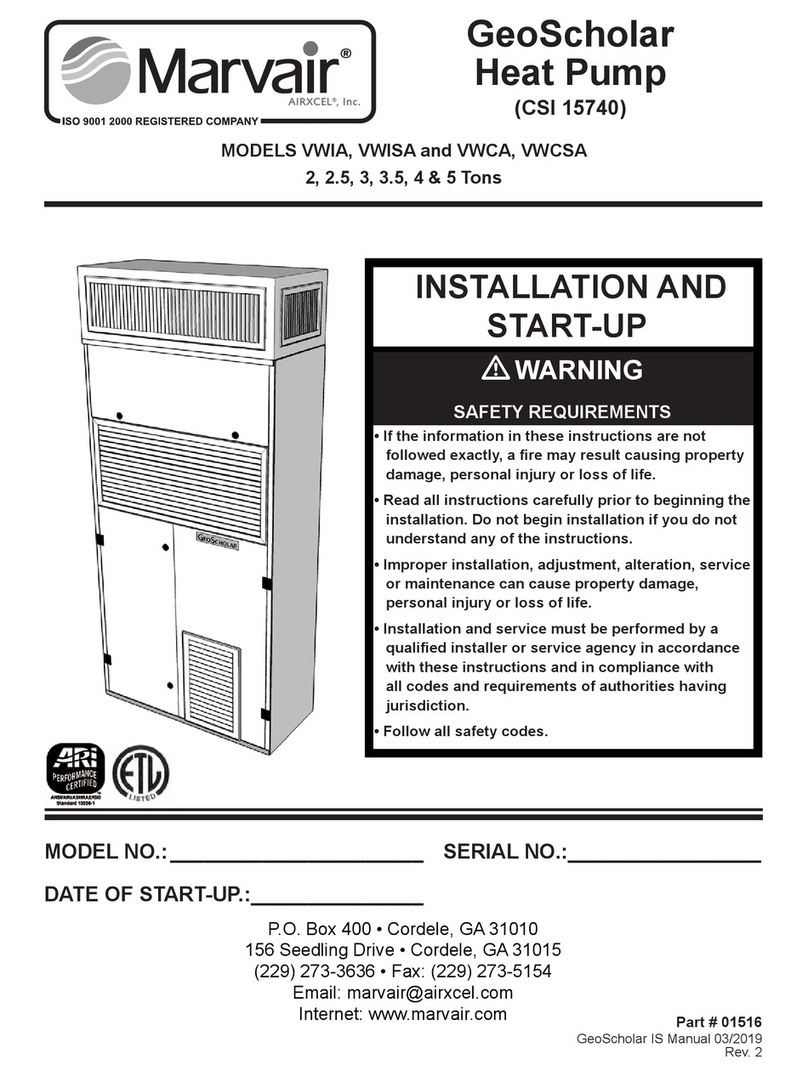
9Marvair Wall Mount H/P MAA1020H-1048H/MGA1072H I&O Manual
02/2021 Rev.2
Quality Components
The GreenWheel®module consists of a desiccant wheel, two blowers and the drive motor and belt. The
two blowers simultaneously pull fresh air from outside and exhaust air from the classroom through the
rotating wheel. Two variable speed blowers ensure that up to 450 CFM of outside air can be brought into
the room and the indoor air is properly exhausted. Variable speed blowers permit that the desired quantity
of outside air is delivered into the room. Optional independent exhaust air blower control allows positive
pressurization of the classroom, i.e., more outside air can be introduced through the GreenWheel® ERV
than is exhausted.
Hot Gas Reheat (HGR) Dehumidification Mode (Special Option “G”)
When the HGR is in the dehumidification mode, the hot gas reheat (HGR) coil is energized. The cooled,
dehumidified air exits the evaporator coil and is blown through the HGR coil. This coil is sized to the
sensible capacity of the unit. The heat in the HGR coil is transferred to the air stream. The use of the HGR
coil allows the indoor humidity of the classroom to be maintained at or below a certain set humidity set
point without over cooling the classroom. These units can not add humidity to the classroom.
The operation of the HGR coil is controlled by a humidity controller. If the humidity rises above the set
point on the controller and the temperature in the classroom is satisfied, both mechanical cooling and
the HGR coil operate to temper the air and lower the humidity. If the temperature in the classroom rises
above or falls below the set point of thermostat and the unit is operating in the dehumidification mode,
the need for cooling or heating will override the call for dehumidification and the HGR coil is disengaged
until the thermostat is satisfied. This assures the classroom temperature is maintained as first priority
and humidity control is second.
The humidity controller or BAS control is required for proper operation of the HGR coil.
1.6 Standard Controls- PC Board
Description of Operation
The PC board controls the operation of the indoor blower, the compressor and the reversing valve while
providing high pressure, loss of charge protection with an integral defrost function. Upon a call for
mechanical cooling or heating, the controller will energize the compressor when a 24 VAC signal is
applied to the “Y” terminal provided that all time delays and fault conditions are satisfied. It will energize
the indoor blower when a 24 VAC signal is applied to the “G” terminal. The reversing valve will be
energized when a 24 VAC signal is applied to the “O” terminal. Electric heat (EH) will be energized
when a 24 VAC signal is applied to the “W2” terminal. The control will monitor the status of the loss
of charge switch and the high pressure switch. If either of these inputs recognize a fault, the compressor
will turn off and the anti-short cycle delay will be initiated. If any of these faults occur twice within a one
hour period, the control will lock the compressor out until the power is reset manually. Note: 24 VAC
power must be continuously applied to “R” and “C”.
The board will also monitor the defrost sensor. If the defrost sensor senses a temperature of 32°F while
in the heat mode, it will initiate a pin selectable 30, 60, or 90 minute delay period. (Factory set at 60
minutes). If the sensor is still calling for defrost at the end of this delay period, it will de-energize the
outdoor fan and energize the reversing valve through the RV terminals. The defrost cycle will terminate
on time or temperature. It will have a maximum defrost run time of 10 minutes, however, if the defrost
sensor registers a temperature of 50°F or higher before the 10 minute maximum run time, the defrost
cycle will terminate. The EH terminals will also be energized during a defrost cycle if the EHDD (Electric
Heat During Defrost) jumper is in the “Yes” position.
The board also provides the ability to vary the speed of the indoor blower motor (electronically commutated
motors excepted) and to select the number of seconds the blower will run after the compressor has turned


































